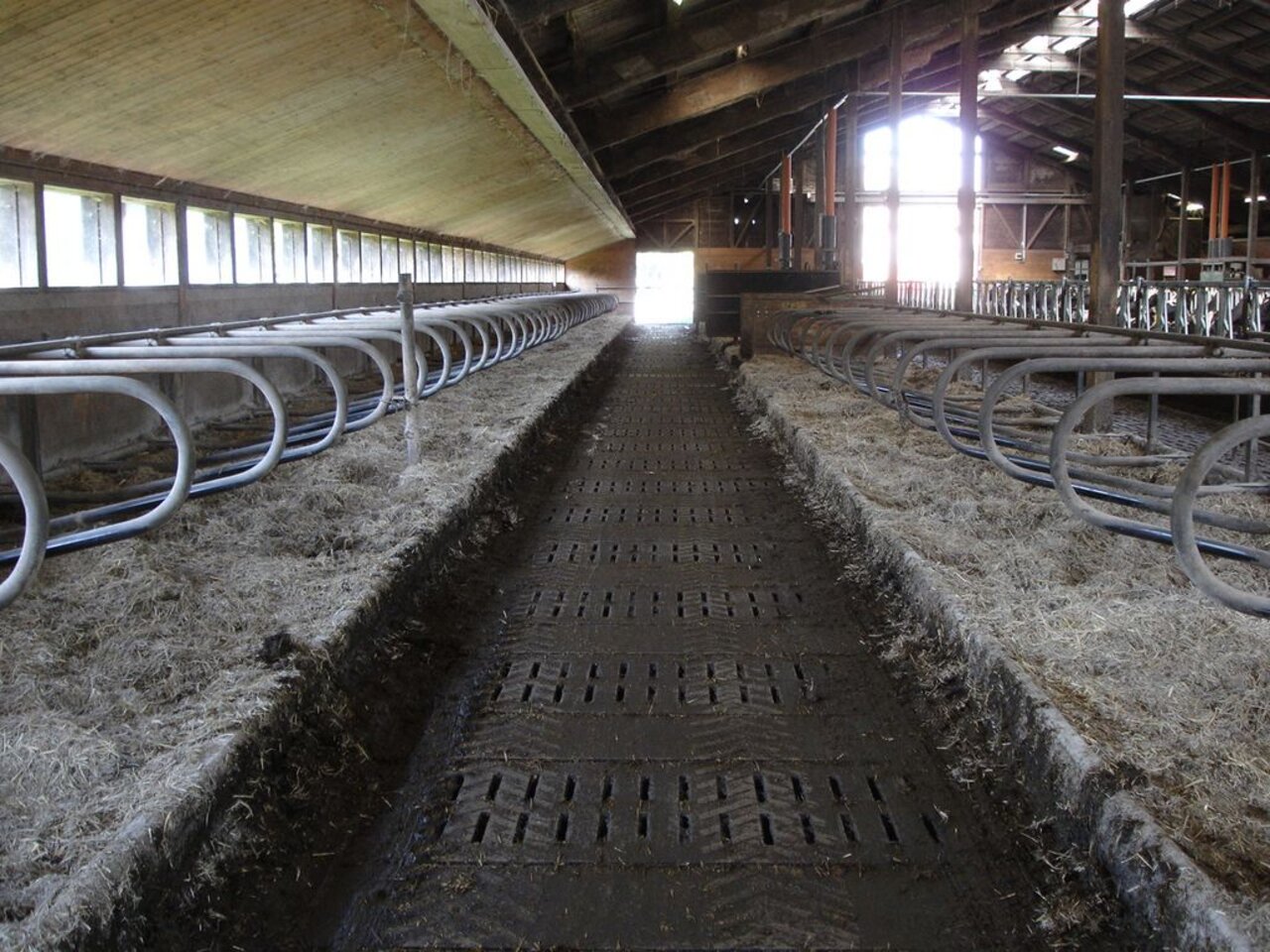Project
Clean floors as ammonia mitigation strategy in dairy barns

Study on Ammonia Reduction in Dairy Barns Using a Cleaning device on Slatted Floors
Keeping dairy cattle in loose housing systems contributes to the total emission of ammonia in high measure. Despite the fact that tie stall housing emitts less ammonia than loose housing systems, nobody would like to return to it due to animal welfare reasons. This is our motivation to evaluate new mitigation strategies in loose housing systems.
Involved external Thünen-Partners
- Westermann GmbH
(Meppen, Deutschland)
Funding Body
-
German Federal Environmental Foundation (DBU)
(national, öffentlich)
Background and Objective
Keeping dairy cattle in loose housing contributes to the total emission of ammonia up to 50% and has its main origin from soiled walking areas like slatted floors. The ammonia emissions from the barns have an impact on the environment, as does the soiled floor on the health of the claws.
Thus, the objective of our study was to evaluate the impact of the manure removal from slatted floor on the ammonia emission in dairy barns.
Approach
The cleaning system used is designed to combine the advantages of a wet and a mechanical cleaning-method. It features high-pressure water nozzles, mechanical star discharge rotors and a rubber-scraper.
For the experiment, six exchangeable concrete slatted floor elements (55cm x 62cm x 20cm) were cut out of the existing floor. This way the test elements could be separated from other sources of ammonia emission and moved into closed chambers (120cm x 80cm x 60cm). Via membrane pumps the air carrying emitted ammonia from the slats was run through a solution of sulphuric acid (0,1n) and determined quantitatively in a lab using a photometer.
Results
Compared to untreated control slats, a reduction of the amount of manure weighted on the clean test elements up to 33.2% could be observed. However, no significant effect of the cleaning of the slats on the ammonia emission could be detected. Average ammonia concentrations measured directly after the cleaning (mean temperature in the barn: 21.1°C) were 13.2 mg NH3 h-1 m-2 (clean) and 16.3 mg NH3 h-1 m-2 (control), respectively.
Thünen-Contact

Involved external Thünen-Partners
- Westermann GmbH
(Meppen, Deutschland)
Funding Body
-
German Federal Environmental Foundation (DBU)
(national, öffentlich)
Duration
4.2009 - 3.2011
Publications
- 0
Retz SK, Georg H, Hensel O (2012) Mechanical cleaning of slatted floors. Landtechnik Agric Eng 67(1):47-50
- 1
Retz SK, Georg H, Hensel O (2012) Mechanische Reinigung von Spaltenböden. Landtechnik Agric Eng 67(1):47-50
- 2
Retz SK, Georg H, Godbout S (2011) Ammonia emission from a 15th year old concrete slatted floor in a dairy barn. In: Godbout S, Potvin L (eds) Concrete for a sustainable agriculture : proceedings of the 7th international symposium ; September 18-21st 2011 Québec City, Canada. Paris: INRA, pp 148-153
- 3
Retz SK, Georg H, Weghe H van den (2011) Einfluss der Reinigungsintensität und der Tierpräsenz auf das Ammoniakemissionsverhalten von Betonspaltenböden in Milchviehlaufställen. In: 10. Tagung: Bau, Technik und Umwelt 2011 in der landwirtschaftlichen Nutztierhaltung. Darmstadt: KTBL, pp 226-231
- 4
Georg H, Retz SK (2011) Emissionsreduktion bei Haltung auf Spaltenböden : Bewertung eines neuartigen Reinigungsverfahrens. In: Bautagung Raumberg-Gumpenstein 2011 gemäß Fortbildungsplan des Bundes "Neue Herausforderungen und Strategien in der Rinder- und Schweinehaltung", 18. und 19. Mai 2011. Irdning: Lehr- und Forschungszentrum für Landwirtschaft Raumberg-Gumpenstein, pp 25-28

![[Translate to English:] [Translate to English:]](/media/_processed_/8/e/csm_Bildschirmfoto_2021-03-03_bearb_fc48ac88bf.jpeg)
![[Translate to English:] [Translate to English:]](/media/_processed_/8/e/csm_Bildschirmfoto_2021-03-03_bearb_ba3ec0e9d7.jpeg)





